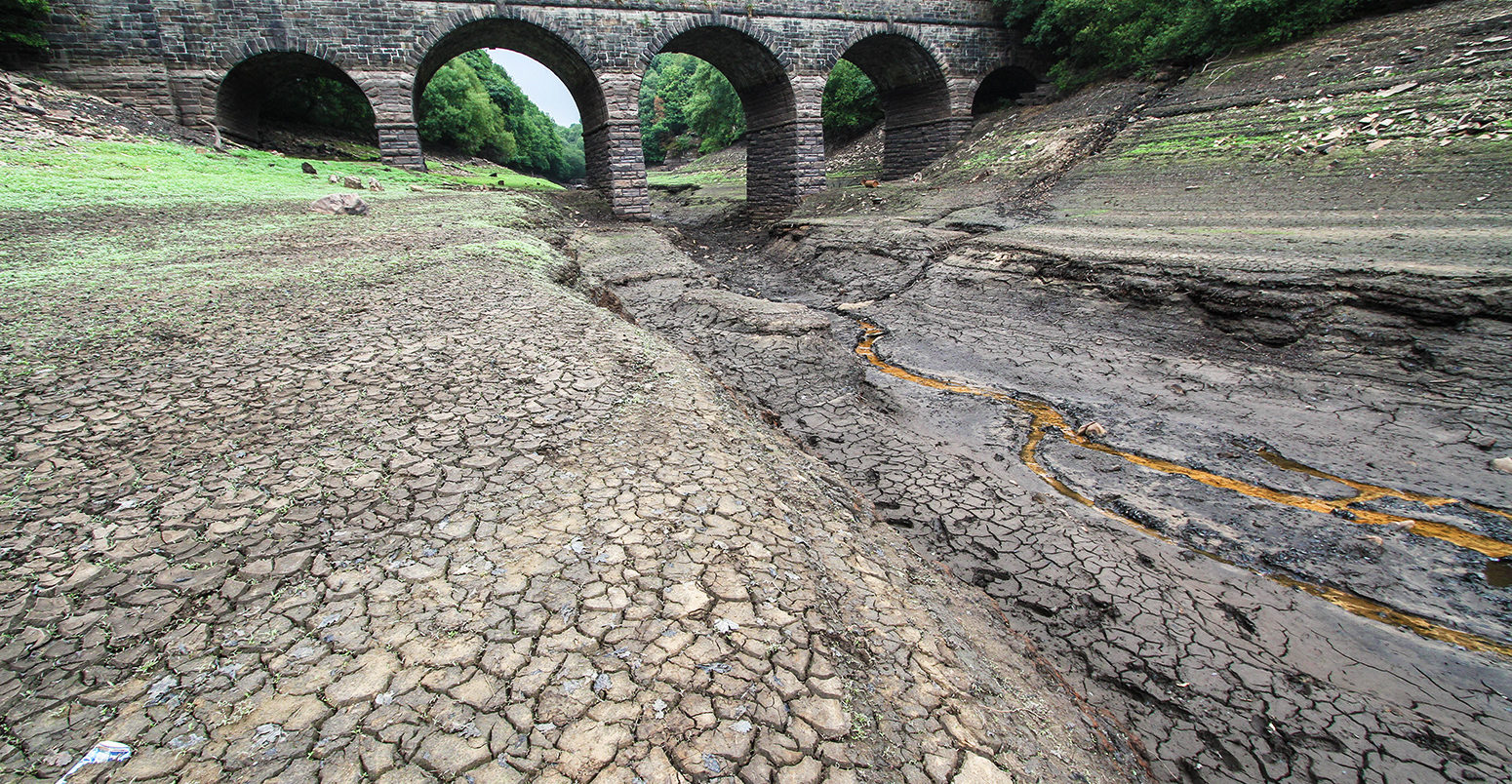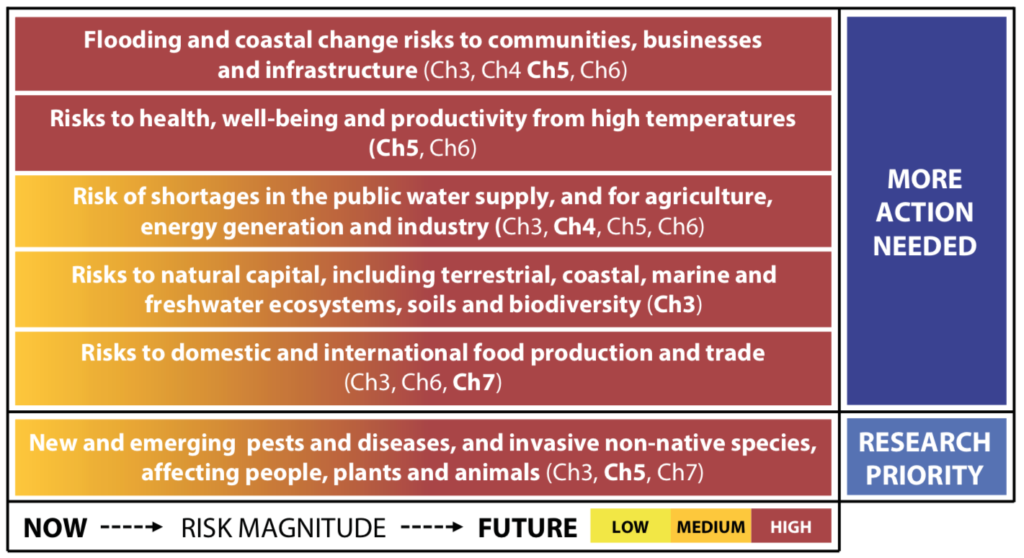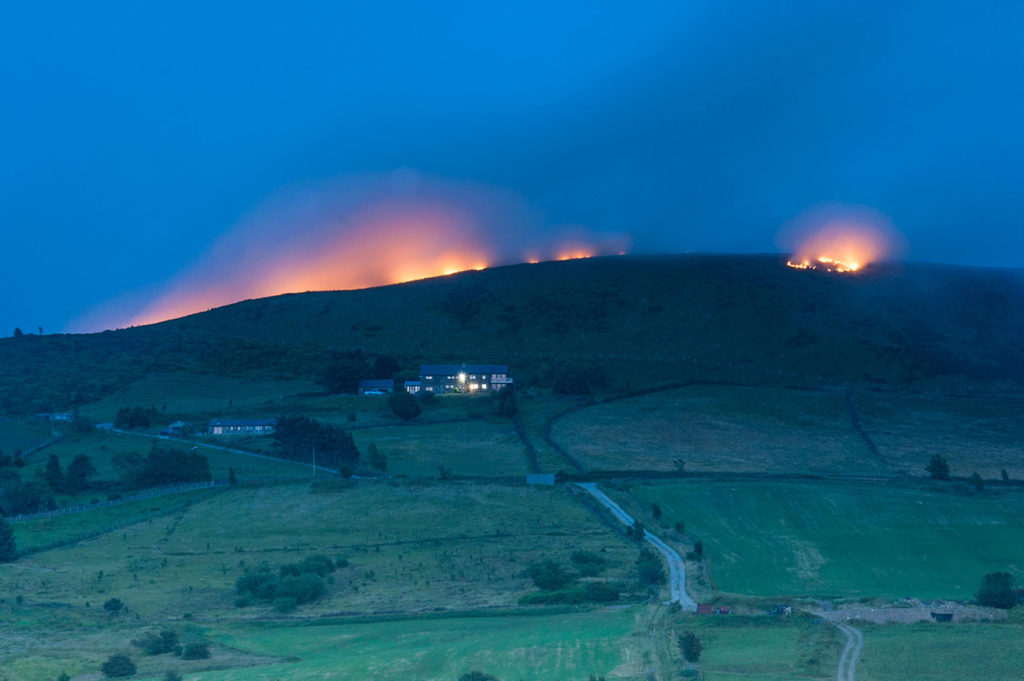
In-depth: How the UK plans to adapt to climate change
Jocelyn Timperley
07.26.18Jocelyn Timperley
26.07.2018 | 12:01amThe UK government last week published its updated strategy for tackling the impacts of climate change, including higher temperatures, drought and flooding.
The 128-page plan is the second iteration of the UK’s National Adaptation Programme (NAP), which sets out the the government’s approach to dealing with current and future climate change. The first NAP was published in 2013; the new version covers 2018 to 2023.
Adaptation aims to reduce vulnerability to the impacts of climate change that are inevitable due to past and current greenhouse gas emissions. Adaptation policy in the UK is a devolved matter. Therefore, the adaptation plan mainly covers England, as well as some wider UK matters.
In a forward to the new plan, Lord Gardiner of Kimble, an environment minister, said it focuses on actions the government and others will undertake to “address the most urgent risks” and “make the country more resilient to climate change”.
But a second report, released today by MPs who sit on the Environmental Audit Committee (EAC), says the government is still not doing enough in one key area of adaptation: resilience to heatwaves. Released in a week where the UK is experiencing a severe heatwave, EAC’s report warns there will be 7,000 heat-related deaths every year in the UK by 2050 – triple the rate now – if the government does not take more action.
The EAC also published another report this week which is highly relevant to the new adaptation plan. On Tuesday, it delivered its verdict on the government’s 25 Year Environment Plan, published in January 2018, which sets out policies to “help the natural world regain and retain good health”.
Tuesday’s EAC report expresses concerns the government is putting too much emphasis on “further consultations and long-term aspirational targets” for the environment, without supporting delivery plans. It recommends the government put the environment plan the plan into law.
In response to these three releases, Carbon Brief takes a look at the UK’s current plans to adapt to climate change – and examines where gaps may remain.
UK climate adaptation: the law
The UK’s legally binding 2008 Climate Change Act (CCA) obliges the government to set out policies to adapt to climate change, in addition to its more widely-known mitigation objectives, which aim to reduce greenhouse gas emissions.
Adaptation policies are largely covered by the Department for Environment, Food and Rural Affairs (Defra), which is tasked with managing increasing risks in areas such as flooding, drought, heat, sea level rise and extreme weather. Mitigation policy, meanwhile, falls under the responsibility of the Department for Business, Energy and Industrial Strategy (BEIS), which last year released its “Clean Growth Strategy”, setting out policies aimed at cutting the UK’s emissions.
Under the adaptation section of the CCA, the government is required to publish a risk assessment of the current and predicted impact of climate change every five years. This is based in part on scientific advice given ahead of the risk assessment from the adaptation sub-committee of the Committee on Climate Change (CCC), the government’s official climate advisors.
The government is then required to lay out an adaptation plan “as soon as is reasonably practicable” setting out policies to address the identified risks. This is the 128-page plan that was published last Thursday.
‘Focused’ priorities?
The CCC’s risk assessment, published in July 2016, emphasised that “the impacts of climate change are already being felt in the UK” and highlighted the six current “most urgent” risks.
In short, they are: flooding, heat, drought, natural capital risks, food and pests.
These are highlighted in the CCC’s graphic below. The yellow-to -ed scale shows the relative urgency of each of these risks now and in the future.

Top six areas of inter-related climate change risks for the UK, as identified by the CCC. Source: CCC Risk Assessment 2016
The CCC also gave a series of recommendations to the government on adaptation.
It should set “clear priorities”, the CCC said, with a “core set of priorities and actions that would have the biggest impact”. It also needs to “ensure outcomes are “outcome-focussed, measurable, time-bound and have clear ownership”, as well as include “effective monitoring and evaluation”.
The government says it has sought to follow this advice. A full verdict on this will come from the CCC next year. However, initial responses from the CCC were not entirely positive.
Chris Stark, chief executive of the CCC, said the plan “looks to have made some headway” on some of the CCC’s six key concerns. However, “it appears that there are gaps”, he says, citing overheating, risks to the UK from climate change overseas and affordability of flood insurance as examples. He adds:
“Urgent risks we have previously highlighted are not addressed, so we will press the government to go further to ensure there is a comprehensive plan to improve the UK’s resilience to the effects of climate change.”
Likewise, Kathryn Brown, head of adaptation at the CCC, wrote in a blog post last week that the new plan does not appear to tackle the key climate-related risks facing the UK.
“[T]his looks like only a partial plan,” she wrote. “In my view…on its own, [it] isn’t meeting the goals the government has set itself.” She added:
“The latest programme includes a set of objectives, actions and owners, but it fails to go any further [than the first NAP] when it comes to setting priorities.
“Nor does it set measurable success criteria with timescales; and apart from a column on monitoring and metrics, there is an absence of discussion on monitoring and evaluation, which is even weaker than the first NAP.”
Brown also said that 27 of the 56 risks and opportunities identified by the CCC are missing from the list of actions given in the adaptation plan. Those missing include 16 “urgent risks”, she says.
Others also critiqued the lack of concrete targets. Heather Jones, policy adviser at Chartered Institution of Water and Environmental Management (CIWEM), tells Carbon Brief she considers the plan “another missed opportunity” to implement a strategic programme for adaptation.
She says:
“It’s another long list of disassociated actions, which are either already in train, or their outcome is not controlled by Defra, which has overall responsibility for production and delivery of the NAP. The targets are also mostly not measurable and, therefore, it will be very difficult to assess progress against them.”
2nd National Adaptation Programme is not the targeted, strategically focused programme we really need. It's another long (150+) list of disassociated actions, most of which are already in train, which are difficult to measure. https://t.co/Heo6Zvlc63 #climatechange #adaptation https://t.co/30Tvs4MyY3
— Heather Gardner (@HeatherG_policy) July 20, 2018
However, some of the plan’s new initiatives were praised, such as a request for some financial regulators to report on climate adaptation. The plan “invites” the Financial Conduct Authority (FCA), Financial Reporting Council (FRC) and The Pensions Regulator to produce reports on how they are incorporating climate impacts into their statutory duties and powers.
Encouraging to see 2nd National Adaptation Programme #NAP support the #25YEP and #GreenFinance Taskforce recs, including inviting financial regulators to report on #adaptation & explain how they are incorporating #resilience to #climatechange https://t.co/35iQZbbhwX @DefraGovUK pic.twitter.com/CIVY2sI0x9
— Aldersgate Group (@AldersgateGrp) July 19, 2018
The adaptation fell short, though, of suggesting mandatory reporting of exposure to climate change risks for large companies and pension funds, as recommended by another recent EAC report and the CCC. The government considers a voluntary reporting process the “most constructive and collaborative approach” for engagement, the plan says.
Overheat
Considering the current heatwave – and increasing focus on its links to climate change – the first question people may ask about the new adaptation plan is how it plans to increase UK’s resilience to heatwaves.
In its 2016 risk assessment, the CCC identified exposure to high temperatures and heatwaves as one of the greatest climate change threats to the UK.

Footballer on parched fields in Stratford, London, 21 July 2018, caused by a prolonged summer heatwave and dry period. Credit: amer ghazzal/Alamy Live News.
It said the average number of hot days per year has been increasing since the 1960s. Heatwaves like the one in 2003, which led to more than 2,000 excess deaths, are “expected to become the norm in summer by the 2040s”, the CCC added.
Meanwhile, the number of vulnerable people at risk is rising due to the UK’s growing and ageing population. “In combination this means the number of premature heat-related deaths is expected to more than triple by the 2050s,” the CCC said. It estimates that currently 2,000 people die prematurely each year in the UK from heat-related conditions.
The CCC also said that tackling the effects of overheating buildings is a particularly important part of policy to address heatwaves. Delayed policies to ensure buildings are operable in high temperatures will “increase risks and lead to longer-term well-being impacts”.
This is how the government introduces the topic in the new adaptation plan published last week:
“We want to ensure that homes and other buildings are well-insulated for winter, while not overheating in the summer. Achieving this aim is likely to require a number of actions, including changes in construction practices, in occupier behaviour and in greater use of green spaces, including historic parks and gardens, whose role in reducing overheating in urban environments is well documented.”
In the adaptation plan, the government points to the recently updated Heatwave Plan for England, published by Public Health England, which sets out guidance for how the NHS, local authorities and other professionals can reduce the health risks from exposure to heat.
It also highlights strategies already underway in public services. The NHS, for example, already plans to embed adaptation into daily practice by 2023 and has included adaptation as a core part of its mandatory sustainable development management plans (SDMPs) for clinics.
But speaking to BBC Newsnight this week, the CCC’s Kathryn Brown said better adaptation of the UK’s buildings for these hotter temperatures – particularly in homes, schools, hospitals and care homes – is “not happening”.
According to the adaptation plan, the housing ministry has commissioned research to better understand the risk of overheating in new homes. This is due to be completed in the summer of 2018 and “will help to inform any future policy on including climate adaptation in new homes to reduce overheating”, the plan says.
But the EAC report on heatwaves published today says that government ministers who were interviewed by the committee of MPs appeared unclear about whether building regulations should address the health aspects of overheating. This is despite a fifth of the UK’s homes already overheating at current temperatures, the EAC says.
(Incidentally, “chronic overheating” during the summer was one of the reasons why the ill-fated combustible cladding was added to Grenfell Tower before the fatal fire last year.)
The EAC report says the government is also failing to communicate how the risks from heat are increasing. This is especially concerning since the public’s opinion, in general, is that heatwaves have not increased over their lifetimes, the report says. Mary Creagh, chair of the EAC, says in a statement released today:
“The government needs to do more to warn the public of the health risks of heatwaves, particularly when they fall outside of the summer period, and should appoint a minister to lead work across government.”
She argues that the new adaptation plan promises “no effective action” to prevent overheating in buildings.
The Brown is also critical of the plan for failing to present actions to reduce the risks to people from overheating in homes. “[This] was one of the highest priority risks identified in the CCRA,” she wrote on her blog.
Brown told Climate Home News that “there needs to be an industry standard, regulation on new builds”. The government argument that it is waiting for the completion of the housing ministry report is “not a commitment,” she added. In a further statement on heatwaves, released yesterday in response to this week’s extreme temperatures, she outlined further action needed to cool homes:
“[N]ew build properties need shading and improved ventilation, as do hospitals. And we need to reverse the decline in urban green spaces that occurred between 2001 and 2016. We will be monitoring progress and reporting our findings to parliament over the coming year.”
https://t.co/oPnPetVg66https://t.co/oPnPetVg66
— Channel 4 News (@Channel4News) July 24, 2018
Drought
Water shortage was another key climate change threat identified by the CCC in 2016. Its risk assessment noted that:
“Climate change is projected to reduce the amount of water in the environment that can be sustainably withdrawn whilst increasing the demand for irrigation during the driest months. At the same time the growing population will create additional demands on already stretched resources in some parts of the country.”
There is still high uncertainty over how climate change will affect seasonal rainfall projections in the UK, as well as the impact on the frequency and intensity of water shortages and drought, the CCC said in its risk assessment. However, it added that there was still an “urgent need” for longer-term water resource planning and further steps to achieve the ambitious reductions in water demand and leakage that are “likely to be required”.
In her statement on heatwaves yesterday, the CCC’s Kathryn Brown also highlighted her concern over water shortages. She said:
“[W]e can expect greater water deficits across the country, including in cooler wetter areas like the north-west of England. The area of land well suited to the production of water-intensive crops, such as rain-fed potatoes, could decline by over 80% by the 2050s.”
The government’s new adaptation plan recognises the risks of shortages in water supply for agriculture, energy generation and industry. It promises to increase water supply, incentivise greater water efficiency and “maintain a plentiful supply”, as demand increases and climate change impacts availability.
The plan also says government will work to “restore natural processes” in rivers to buffer against drought and help wildlife, and work towards setting “challenging and ambitious goals” to reduce water leakage.
The plan lays out a goal to increase the proportion of water bodies with enough water to “support environmental standards” to 90% for surface water and 77% for groundwater by 2021. But, beyond this, there is little in the way of specifics regarding monitoring and metrics.
The government’s Environment Agency says it will also track a suite of metrics in England via a sustainable abstraction “dashboard”.
However, the EAC heatwaves report released today criticises progress so far on water shortages. The government has “weakened its water efficiency ambitions”, it says, as well as overlooked industry requests to make per capita consumption limits more efficient for new builds. The report adds:
“A water-saving culture needs to be embedded to ensure that people understand the strain heatwaves place on the water supply and to make more water is available during a heatwave.”
Floods
In the middle of a summer heatwave, the problem of flooding may seem distant.
However, tackling flooding has still been in the news this week, after Michael Gove, the environment secretary, released a pair of Eurasian beavers into Gloucestershire’s Forest of Dean as part of a reintroduction scheme which Defra hopes could also reduce local flood risk.
.@michaelgove announced £20,000 for research into reintroductions of #beavers. @DevonWildlife will benefit from this funding to their trial project on the River Otter. https://t.co/KdYaJlcIsS #BeaverFever pic.twitter.com/H1cpw6oQBr
— Defra UK (@DefraGovUK) July 24, 2018
(Carbon Brief last year mapped the government’s current distribution of funding for flood protection in England).
Flooding and coastal change risks were another key climate risk outlined in the CCC’s 2016 risk assessment. Flood damages are already high in the UK, averaging an estimated £1bn per year, the CCC said, and are expected to increase due to climate change. Current levels of adaptation are projected to be “insufficient” to avoid the increased damages from further warming, the report said.
Additional adaptation may be able to counter the increase in flood damages anticipated with 2C of global warming, the report added, at least in some parts of the UK. But, in other parts, it added that increasing flood risks appear inevitable, especially with 4C or more of global warming.
The government’s new adaptation plan released last week acknowledges that climate change is likely to increase flood risk in England, with the resulting impacts this could have on infrastructure such as transport, telecommunications, businesses and public services.
However, its “actions log” is, again, relatively short of clear monitoring targets. The plan says the government will update its flood and coastal erosion risk management strategy by 2019 and also publish a statement setting out its “future expectations for managing flood risk and coastal erosion” in the winter of 2018.
The CCC’s Kathryn Brown noted in her blog that actions to manage the transition period ahead of the withdrawal of the Flood Re scheme is a key gap in the adaptation plan. The scheme, which helps people living in flood risk areas to get affordable home insurance, will end in 2039. The scheme has warned that action is needed beyond this to ensure premiums and excesses remain affordable for the majority of households.
Wildfire
During the recent bought of wildfires in the UK, including a three-week long blaze in Saddleworth Moor, the government faced calls to need to re-examine its capacity to deal with similar fires in future. Scientists have warned that Northern Europe should expect more such fires as extreme weather events become more common due to climate change.

Moorland fire at Saddleworth, Greater Manchester, UK, June 2018. Credit: Matthew Wilkinson/Alamy Live News.
It’s worth noting that it is only relatively recently that wildfire has even been recognised as a significant hazard in the UK: it was only included in the UK’s National Risk Register in 2013. The most recent version of this register says:
“Climate change is likely to lead to changes in the rainfall patterns that affect the UK. If we experience longer drier summers, this will increase the risk of drought and could lead to more frequent, larger wildfires.”
The CCC’s 2016 risk assessment also said climate change is projected to increase the risks of wildfires. However, it only advised the government to “continue current efforts” to manage and respond to wildfires.
The adaptation plan does just this. It promises to provide wildfire prevention training to fire services and land managers, to develop a “forestland wildfire risk and fuel map”, and to improve wildfire prediction systems.
https://twitter.com/paulkeenlyside/status/1019985962384969728
Food and soil
Soil aridity was one of several areas of the UK’s “natural capital” highlighted by the CCC in its risk assessment as needing more “action”. The CCC warned that the proportion of agricultural land in England and Wales classed as “best and most versatile” is projected to decline from 38% to 9% by the 2050s under a high climate change scenario.
The CCC said more action was needed to “reduce existing pressures on soils, increase uptake of soil conservation measures and restore degraded soils”.
The 25-year environment plan said that the government wants “all of England’s soils to be managed sustainably” by 2030 and outlined plans to developing a “soil health index”. It also said Defra would “invest at least £200,000 to help create meaningful metrics that will allow us to assess soil improvements”.
The adaptation plan appears to contain little in addition to these previous announcements and no clearer targets. It also reiterates an environment-plan promise to publish an “England peat strategy” in late 2018.
Food security was another key area highlighted by the CCC risk assessment – although the government disagreed with the CCC’s severity of risk in some areas of food. The adaptation plan promises to “ensure a food supply chain which is resilient to the effects of a changing climate”.
It also pledges to publish an updated UK food security assessment by the end of 2019. The last of these assessments, which cover the UK’s food supply (domestic and imported), was published in 2009.
Kathryn Brown says in her blog that, despite the CCC highlighting the risks to the UK from climate change impacts abroad, this update is the only action in the adaptation plan directed at managing these risks.
Environment plan
The new adaptation plan includes 13 of the goals set out in the 25-year environment plan, also published by Defra.
For example, in its section on how to build ecological resilience and protect wildlife at particular risk from climate change, it refers to environment-plan goals to create or restore 500,000 extra hectares of wildlife-rich habitat by 2042.
The environment plan was welcomed at the time of its release for setting out a long-term environmental strategy, but was also criticised for being too vague on objectives and lacking direction on enforcement of environmental policy.
The EAC report on the 25-year plan released on Tuesday also welcomes its ambition for the restoration and recovery of the natural environment. However, it echoes concerns that the plan lacks details of how it will achieve its objectives.
It calls for the UK to implement a body of new legislation on the environment, via a new Environmental Governance and Principles Act.
This EAC says this should include a replacement of the third of EU environmental legislation that cannot be copied and pasted into UK law post-Brexit, as well as establish the principle in UK law that environmental protection will be ensured. A new “Environmental Enforcement and Audit Office” should also be created to measure progress and enforce the new law, it adds.
The government has already announced plans for a new statutory environmental watchdog to be established after Brexit, although this will lack power to prosecute the government. The exclusion of climate change from the proposed watchdog has also caused concern.
The CCC has backed this decision, arguing that including climate change would duplicate their statutory role in scrutinising climate policy. However, Baroness Brown (not Kathryn Brown), who is chair of the CCC’s sub-committee on adaptation, also told the EAC that the new body should have the ability to consider climate change as part of an assessment of the environment plan.
Looking ahead
The CCC will assess the government’s new adaptation plan fully in its next progress report, due to be released in June 2019. The CCC evaluates UK adaptation policy every two years, with the 2017 progress report the last to cover adaptation.
Scotland’s second five-year adaptation programme is due to be published in 2019, following its first in 2014.
Wales’s new adaptation plan is due later this year. (The Welsh government also recently announced a £56m programme to improve flood and coastal defences over the next year.)
Northern Ireland also has an adaptation programme, published in 2014, but it still needs to respond to the relevant parts of the UK’s 2017 risk assessment.
Also due later in 2018 is a major upgrade to the UK’s official climate projections (known as “UKCP18”). These will be based on “improved climate models and up-to-date observational records”. The projections were last updated in 2009, so there could be significant changes.
This could have knock on effects on future adaptation policy, as they will inform the government’s third and fourth climate change risk assessments, due in 2022 and 2027, and subsequent adaptation plans.
-
In-depth: How the UK plans to adapt to climate change
-
Heatwaves and floods: how the UK plans to adapt to climate change



